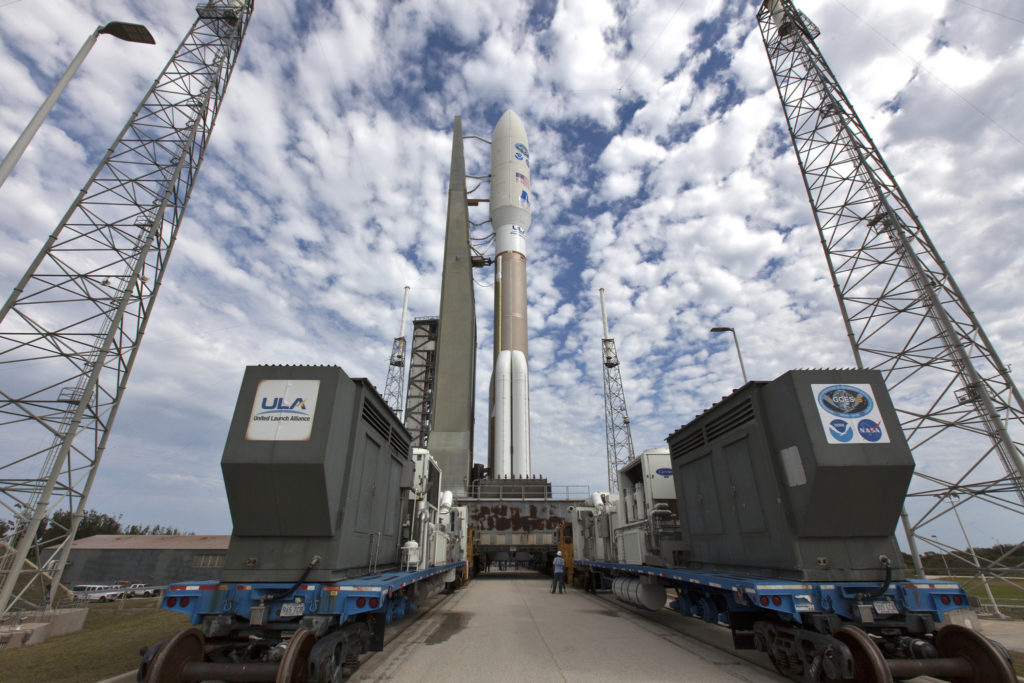Watch the live webcast with NASA Edge during the GOES-S launch vehicle rollout at SLC-41. The live show begins at 10 a.m. and can be viewed on NASA TV and social media at:
NASA TV: www.nasa.gov/live
NASA EDGE Facebook: www.facebook.com/nasaedgefan
NASA EDGE YouTube: www.youtube.com/user/NASAedge
NASA EDGE Ustream: www.ustream.tv/nasaedge
Guests on the show:
Sandra Smalley, director, Joint Agency Satellite Division, NASA Headquarters
Mike Stringer, GOES-R assistant system program director, NOAA
Ed Grigsby, GOES-R deputy system program director, NASA Goddard Space Flight Center
Pam Sullivan, GOES-R flight project manager, NASA Goddard Space Flight Center
Mic Woltman, chief, Fleet Systems Integration Branch, Launch Services Program, Kennedy Space Center
Watch the GOES-S NASA Social Briefing live on NASA TV at 11 a.m. at https://www.nasa.gov/nasalive.
Briefing Participants:
Tim Walsh, GOES-R System Program Director
Pam Sullivan, Flight Director, GOES-R
AJ Sandora, Lockheed Martin GOES-R Series Mechanical Operations ATLO Manager
Mic Woltman, Chief – Fleet Systems Integration Branch, Launch Services Program
Gabriel Rodriguez-Mena, Systems Test Engineer, United Launch Alliance
Joe Pica, Director, Office of Observations, NOAA’s National Weather Service
GOES-S Countdown to T-Zero, Episode 3: Rocket Science
The United Launch Alliance Atlas V rocket reaches another major milestone on the road to T-Zero, as NOAA’s GOES-S spacecraft prepares for launch. Stacking the rocket begins with the booster – the largest component – and continues with the addition of four solid rocket motors and the Centaur upper stage. GOES-S, the next in a series of advanced weather satellites, is slated to launch aboard the Atlas V from Cape Canaveral Air Force Station in Florida. Visit https://youtu.be/gWC9WTQ2Blc
 The United Launch Alliance Atlas V rocket is rolled from the Vertical Integration Facility to the pad at Space Launch Complex 41 at Cape Canaveral Air Force Station in Florida. The launch vehicle will send NOAA’s Geostationary Operational Environmental Satellite (GOES-S) into orbit. The GOES series is designed to significantly improve the detection and observation of environmental phenomena that directly affect public safety, protection of property and the nation’s economic health and prosperity. GOES-S is slated to lift off atop the Atlas V rocket March 1 at 5:02 p.m. EST.
The United Launch Alliance Atlas V rocket is rolled from the Vertical Integration Facility to the pad at Space Launch Complex 41 at Cape Canaveral Air Force Station in Florida. The launch vehicle will send NOAA’s Geostationary Operational Environmental Satellite (GOES-S) into orbit. The GOES series is designed to significantly improve the detection and observation of environmental phenomena that directly affect public safety, protection of property and the nation’s economic health and prosperity. GOES-S is slated to lift off atop the Atlas V rocket March 1 at 5:02 p.m. EST.
 With only two days remaining until the scheduled launch of NOAA’s GOES-S satellite, launch and mission managers are gathering at NASA’s Kennedy Space Center to provide briefings on launch status and the science aspects of the GOES-R series of advanced weather satellites. A prelaunch status briefing will be held at 1 p.m., followed by a science briefing at 2:30 p.m. Both briefings will be held at Kennedy’s Press Site TV Auditorium and air live on NASA Television and the agency’s
With only two days remaining until the scheduled launch of NOAA’s GOES-S satellite, launch and mission managers are gathering at NASA’s Kennedy Space Center to provide briefings on launch status and the science aspects of the GOES-R series of advanced weather satellites. A prelaunch status briefing will be held at 1 p.m., followed by a science briefing at 2:30 p.m. Both briefings will be held at Kennedy’s Press Site TV Auditorium and air live on NASA Television and the agency’s 

